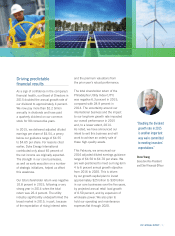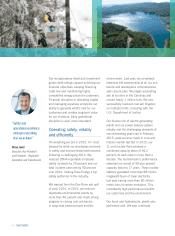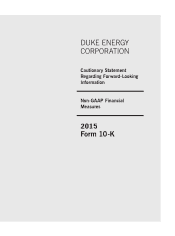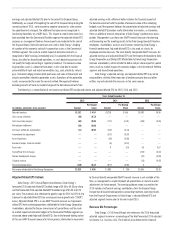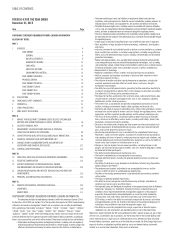Duke Energy 2015 Annual Report Download - page 17
Download and view the complete annual report
Please find page 17 of the 2015 Duke Energy annual report below. You can navigate through the pages in the report by either clicking on the pages listed below, or by using the keyword search tool below to find specific information within the annual report.
FORWARD-LOOKING INFORMATION
This document includes forward-looking statements within the meaning
of Section 27A of the Securities Act of 1933 and Section 21E of the Securities
Exchange Act of 1934. Forward-looking statements are based on management’s
beliefs and assumptions and can often be identified by terms and phrases that
include “anticipate,” “believe,” “intend,” “estimate,” “expect,” “continue,”
“should,” “could,” “may,” “plan,” “project,” “predict,” “will,” “potential,”
“forecast,” “target,” “guidance,” “outlook” or other similar terminology. Various
factors may cause actual results to be materially different than the suggested
outcomes within forward-looking statements; accordingly, there is no assurance
that such results will be realized. These factors include, but are not limited
to: state, federal and foreign legislative and regulatory initiatives, including
costs of compliance with existing and future environmental requirements or
climate change, as well as rulings that affect cost and investment recovery
or have an impact on rate structures or market prices; the extent and timing
of costs and liabilities to comply with federal and state regulations related to
coal ash, including amounts for the required closure of certain ash basins, are
uncertain and difficult to estimate; the ability to recover eligible costs, including
amounts associated with coal ash basin asset retirement obligations and
future significant weather events, and earn an adequate return on investment
through the regulatory process; the costs of decommissioning Crystal River Unit
3 and other nuclear facilities could prove to be more extensive than amounts
estimated and all costs may not be fully recoverable through the regulatory
process; credit ratings of Duke Energy Corporation, Duke Energy Carolinas, LLC,
Progress Energy, Inc., Duke Energy Progress, LLC, Duke Energy Florida, LLC, Duke
Energy Ohio, Inc. and Duke Energy Indiana, LLC (collectively, the Duke Energy
Registrants) may be different from what is expected; costs and effects of legal and
administrative proceedings, settlements, investigations and claims; industrial,
commercial and residential growth or decline in service territories or customer
bases resulting from variations in customer usage patterns, including energy
efficiency efforts and use of alternative energy sources, including self-generation
and distributed generation technologies; advancements in technology; additional
competition in electric markets and continued industry consolidation; political,
economic and regulatory uncertainty in Brazil and other countries in which
Duke Energy conducts business; the influence of weather and other natural
phenomena on operations, including the economic, operational and other effects
of severe storms, hurricanes, droughts, earthquakes and tornadoes; the ability
to successfully operate electric generating facilities and deliver electricity to
customers including direct or indirect effects to the company resulting from an
incident that affects the U.S. electric grid or generating resources; the impact on
facilities and business from a terrorist attack, cybersecurity threats, data security
breaches, and other catastrophic events such as fires, explosions, pandemic
health events or other similar occurrences; the inherent risks associated with the
operation and potential construction of nuclear facilities, including environmental,
health, safety, regulatory and financial risks; the timing and extent of changes
in commodity prices, interest rates and foreign currency exchange rates and the
ability to recover such costs through the regulatory process, where appropriate,
and their impact on liquidity positions and the value of underlying assets; the
results of financing efforts, including the ability to obtain financing on favorable
terms, which can be affected by various factors, including credit ratings, interest
rate fluctuations and general economic conditions; declines in the market prices
of equity and fixed income securities and resultant cash funding requirements for
defined benefit pension plans, other post-retirement benefit plans, and nuclear
decommissioning trust funds; construction and development risks associated with
the completion of Duke Energy Registrants’ capital investment projects, including
risks related to financing, obtaining and complying with terms of permits, meeting
construction budgets and schedules, and satisfying operating and environmental
performance standards, as well as the ability to recover costs from customers in
a timely manner or at all; changes in rules for regional transmission organizations,
including changes in rate designs and new and evolving capacity markets,
and risks related to obligations created by the default of other participants; the
ability to control operation and maintenance costs; the level of creditworthiness
of counterparties to transactions; employee workforce factors, including the
potential inability to attract and retain key personnel; the ability of subsidiaries to
pay dividends or distributions to Duke Energy Corporation holding company (the
Parent); the performance of projects undertaken by our nonregulated businesses
and the success of efforts to invest in and develop new opportunities; the effect
of accounting pronouncements issued periodically by accounting standard-
setting bodies; the impact of potential goodwill impairments; the ability to
reinvest prospective undistributed earnings of foreign subsidiaries or repatriate
such earnings on a tax-efficient basis; the expected timing and likelihood of
completion of the proposed acquisition of Piedmont Natural Gas Company, Inc.
(Piedmont), including the timing, receipt and terms and conditions of any required
governmental and regulatory approvals of the proposed acquisition that could
reduce anticipated benefits or cause the parties to abandon the acquisition, and
under certain specified circumstance pay a termination fee of $250 million, as
well as the ability to successfully integrate the businesses and realize anticipated
benefits and the risk that the credit ratings of the combined company or its
subsidiaries may be different from what the companies expect; and the ability to
successfully complete future merger, acquisition or divestiture plans.
Additional risks and uncertainties are identified and discussed in the
Duke Energy Registrants’ reports filed with the SEC and available at the SEC’s
website at www.sec.gov. In light of these risks, uncertainties and assumptions,
the events described in the forward-looking statements might not occur or
might occur to a different extent or at a different time than described. Forward-
looking statements speak only as of the date they are made; the Duke Energy
Registrants expressly disclaim an obligation to publicly update or revise any
forward-looking statements, whether as a result of new information, future
events or otherwise.
NON-GAAP MEASURES
Adjusted Earnings and Adjusted Diluted Earnings per Share (“EPS”)
Duke Energy’s 2015 Annual Report references 2015, 2014 and 2013
Adjusted diluted EPS of $4.54, $4.55 and $4.36, respectively.
Management evaluates financial performance in part based on the
non-GAAP financial measures, adjusted earnings and adjusted diluted EPS.
These items are measured as income from continuing operations net of
income (loss) attributable to noncontrolling interests, adjusted for the dollar
and per share impact of mark-to-market impacts of economic hedges in
the Commercial Portfolio segment and special items including the operating
results of the Disposal Group classified as discontinued operations for
GAAP purposes. Special items represent certain charges and credits, which
management believes will not be recurring on a regular basis, although it is
reasonably possible such charges and credits could recur. Operating results
of the Disposal Group sold to Dynegy are reported as discontinued operations,
including a portion of the mark-to-market adjustments associated with
derivative contracts. Management believes that including the operating results
of the Disposal Group reported as Discontinued operations better reflects its
financial performance and therefore has included these results in adjusted


